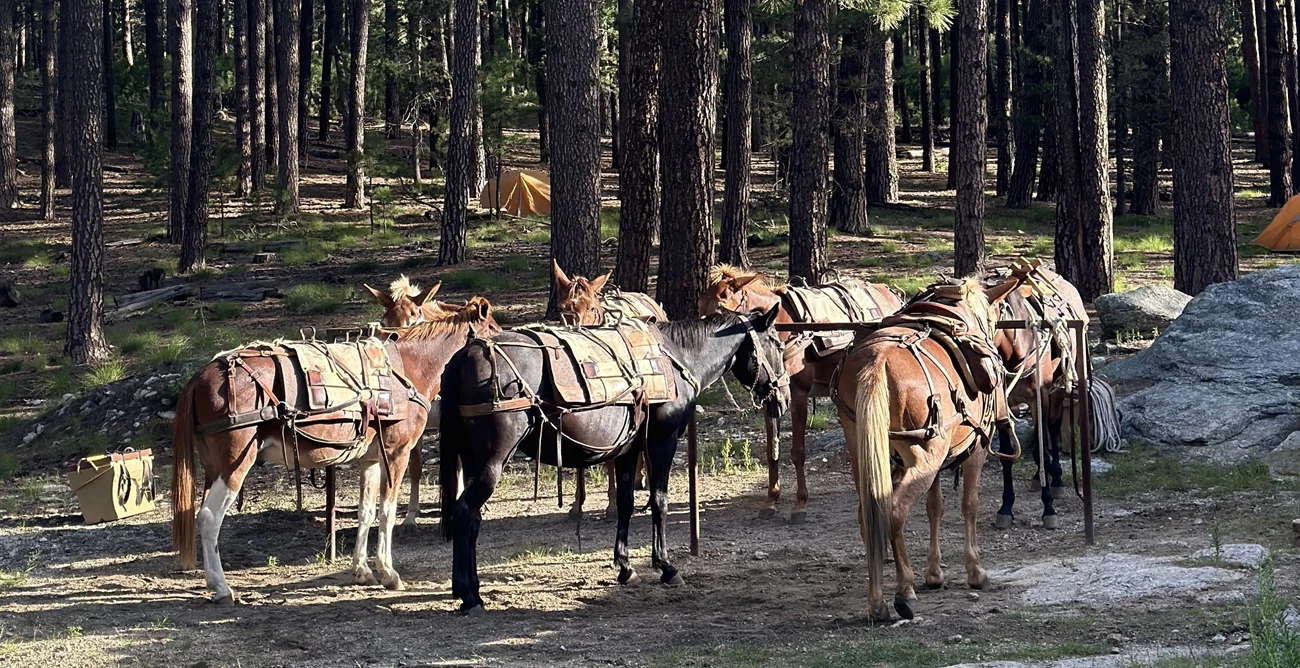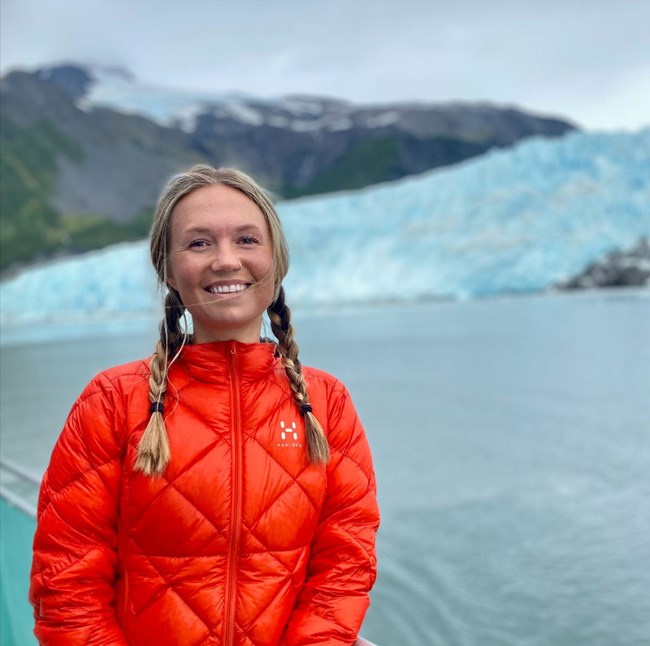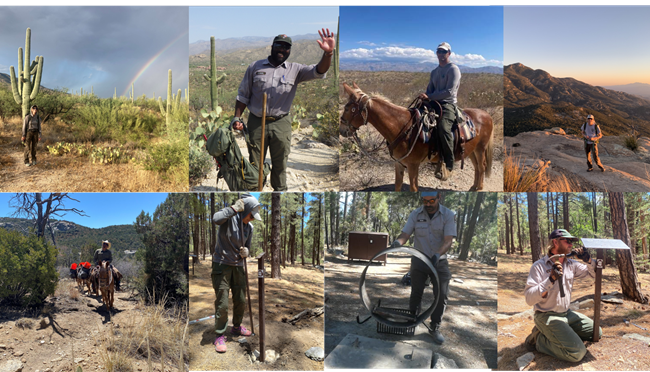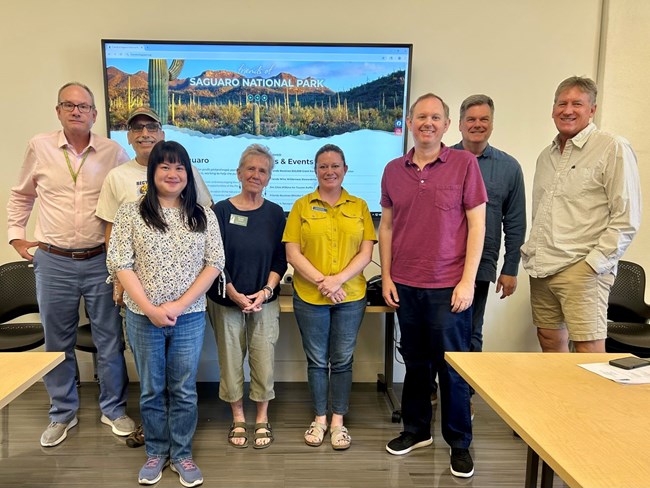Last updated: August 7, 2025
Article
2025 Excellence in Wilderness Stewardship Awards
The National Park Service (NPS) Excellence in Wilderness Stewardship Awards are the agency's annual recognition of outstanding contributions to wilderness stewardship by an individual, team, and external partner, including those involving interpretation and education; management of natural, cultural, and social resources; planning; protection; and maintenance operations. Award recipients are nominated by fellow NPS staff and selected by an interdisciplinary panel.
The following award recipients will be honored in the 2025 NPS servicewide awards ceremony for accomplishments achieved in 2024.
Want to learn more about NPS wilderness? Visit NPS.gov/wilderness

NPS

NPS
Individual Award: Brenna McGown
Due to staffing shortages, Wrangell-St. Elias National Park and Preserve requested assistance from the NPS Alaska Regional Planning and Compliance Team to help them review potential actions in wilderness to ensure wilderness character preservation and develop essential associated minimum requirements analyses (MRA). Brenna McGown, Alaska Regional Outdoor Recreation Planner, stepped in to offer the park pitch-hitting assistance as primary author and project manager for completion of these MRAs with enthusiasm and professionalism, for a period spanning almost two years.
Brenna went above and beyond to learn more about the Wrangell-St. Elias Wilderness, the largest wilderness area in the country, alongside the park’s compliance processes and proposed actions. Brenna worked closely and collaboratively with staff from both the park and inventory and monitoring networks to gather and analyze appropriate information, discuss alternative courses of actions to lessen impacts to wilderness character, and complete MRAs. Brenna’s organization, facilitation, and problem-solving skills were of paramount importance during this period. Brenna was conscientious, diplomatic, and adept at navigating difficult conversations to reach consensus on the best path forward.
Brenna’s leadership in thoughtfully completing MRAs spanned many disciplines and topic areas in the park:
- Wolf pack monitoring range, distribution, and diet
- Steamboat Creek – Chakina Fire effects monitoring
- Climate station monitoring and maintenance
- Understanding coupled hydrologic and glacier dynamic instabilities from the surge of Turner Glacier
- Forest Inventory and Analysis
- Film ski descent of University Peak
Brenna was also a highly valuable member of the region’s Backcountry and Wilderness Advisory Group, contributing to setting wilderness stewardship priorities for the region and informing park wilderness coordinators of planning/compliance issues that may affect their parks. Brenna led two complex regional compliance initiatives that have had a big impact on the wilderness resource - Forest Inventory Analysis and (ongoing) Radio Repeater Maintenance. These are two of the most helicopter- and installation-intensive projects the regional wilderness coordinator has seen in 25 years. Due to their complexity and sensitive nature, these regionwide projects required careful scrutiny and compliance with wilderness law and policy to ensure wilderness character was minimally impacted.

NPS
Team Award: Saguaro National Park Trails Program
The Saguaro National Park Trails Program is a team of approximately 35 dedicated professionals who maintain 180 miles of trails, 78% of which traverse designated wilderness. Their work upholds the NPS mission by balancing resource protection, wilderness stewardship, and visitor access while adhering to the highest standards of professionalism.In 2024, the trails program employed traditional techniques such as dry-stone masonry and crosscut saws to construct and repair trail structures using local materials. The program also collected trail accessibility data using the High-Efficiency Trails Assessment Process (HETAP), mapping 29 miles of trails to inform visitors about conditions before entering the Saguaro Wilderness. This data will be integrated into ten new trailhead panels and park media to inform visitors using mobility devices.
The trails program cleared more than 100 downed trees from wilderness trails using crosscut saws, preventing obstacles that could force hikers off-trail. Mule teams transported up to 200 pounds per mule, supporting logistics for tools and supplies in remote wilderness locations. The program supported over 25 search and rescue operations by ensuring wilderness trails remained passable for first responders. High-elevation stewardship also remained a priority. Two wilderness rangers and two mule pack teams sustained operations at Manning Camp, maintaining six campgrounds, six toilets, and 30 miles of high-elevation trails. The team facilitated 998 campground reservations through Recreation.gov, ensuring managed visitor access to wilderness campsites. Crews also maintained defensible spaces at Manning Camp, cleared downed trees, and ensured viable escape routes for emergency personnel. Mule teams transported over 800 pounds of firefighting tools and supplies, reducing reliance on motor vehicles and mechanical transport in wilderness.
For the trails program, collaboration is key to success. They worked with the Friends of Saguaro National Park and the Arizona Trail Association to fund, design, and install low-impact wayfinding signs along the park’s 14-mile Arizona Trail section, helping visitors navigate remote terrain while maintaining a sense of discovery and solitude. And through hands-on trail restoration, youth participants developed an appreciation for conservation and sustainable practices. The program engaged Youth Conservation Corps (YCC) crews, Next Generation Ranger interns, the Arizona Trail Veterans Program, and volunteers in projects that reinforced wilderness stewardship, resource protection, and Leave No Trace ethics. In 2024, the trails program also collaborated with other sites to provide trail maintenance and construction support:
- Trail restoration in the Chiricahua National Monument Wilderness, Miller Creek Wilderness (Coronado National Forest), and Gila Wilderness (Gila National Forest)
- Boundary fence repair in Death Valley National Park
- Remote land surveys using mule pack operations in the Bandelier Wilderness

Fred Stula
External Partner: Friends of Saguaro National Park
In 2024, donor funding from the Friends of Saguaro National Park (FOSNP) supported wilderness stewardship and the preservation of wilderness character through direct project funding and matching funds. Wilderness stewardship work supported by FOSNP funding included wildlife and plant surveys, trail work, education and outreach, and youth internship programs.
High-elevation surveys in the remote Rincon Mountains provided critical data on key species, including the threatened Mexican Spotted Owl, quaking aspen, and American black bear. As part of the Next Generation Ranger Corps Internship Program, interns conducted species monitoring, genetic sampling, and refined aspen protocols, ensuring data-driven conservation strategies aligned with wilderness stewardship goals. Additional efforts restored natural conditions and improved the undeveloped quality of wilderness character in the Saguaro Wilderness through the removal of obsolete barbed-wire fencing in both park districts, reconnecting wildlife corridors and improving habitat for migratory species.
Four interns were hired through the Next Generation Ranger Corps Internship Program, providing them with immersive wilderness stewardship training. Two interns served as crew leaders for the Youth Conservation Corps, mentoring students through an eight-week program focused on trail work and environmental education. The remaining two interns worked on trail crews, supporting critical maintenance efforts in wilderness areas. In 2024, interns contributed 33,516 hours to park operations, including species research, invasive species control, fence removal, trail maintenance, education, and visitor engagement. FOSNP also funded new mules and packer training, ensuring backcountry access while maintaining traditional, low-impact wilderness travel.
Wilderness safety and emergency response capabilities were strengthened, ensuring rangers are equipped for backcountry search and rescue operations. Key improvements included replenishing medical kits, expanding heat-related heat-related illness response tools, and providing specialized survival gear. Dark Sky Week celebrations, following Saguaro National Park’s 2023 designation as an Urban Night Sky Place, highlighted the intersection of cultural heritage and wilderness preservation in 2024. Cultural demonstrations, interpretive waysides, and portable red lights for evening programs deepened visitor understanding of dark sky conservation and reinforced the role of natural nightscapes in preserving wilderness character in the park.
The funding and collaboration provided by FOSNP supported holistic wilderness stewardship for the park throughout 2024 and helps ensure the Saguaro Wilderness will be protected for future generations.
